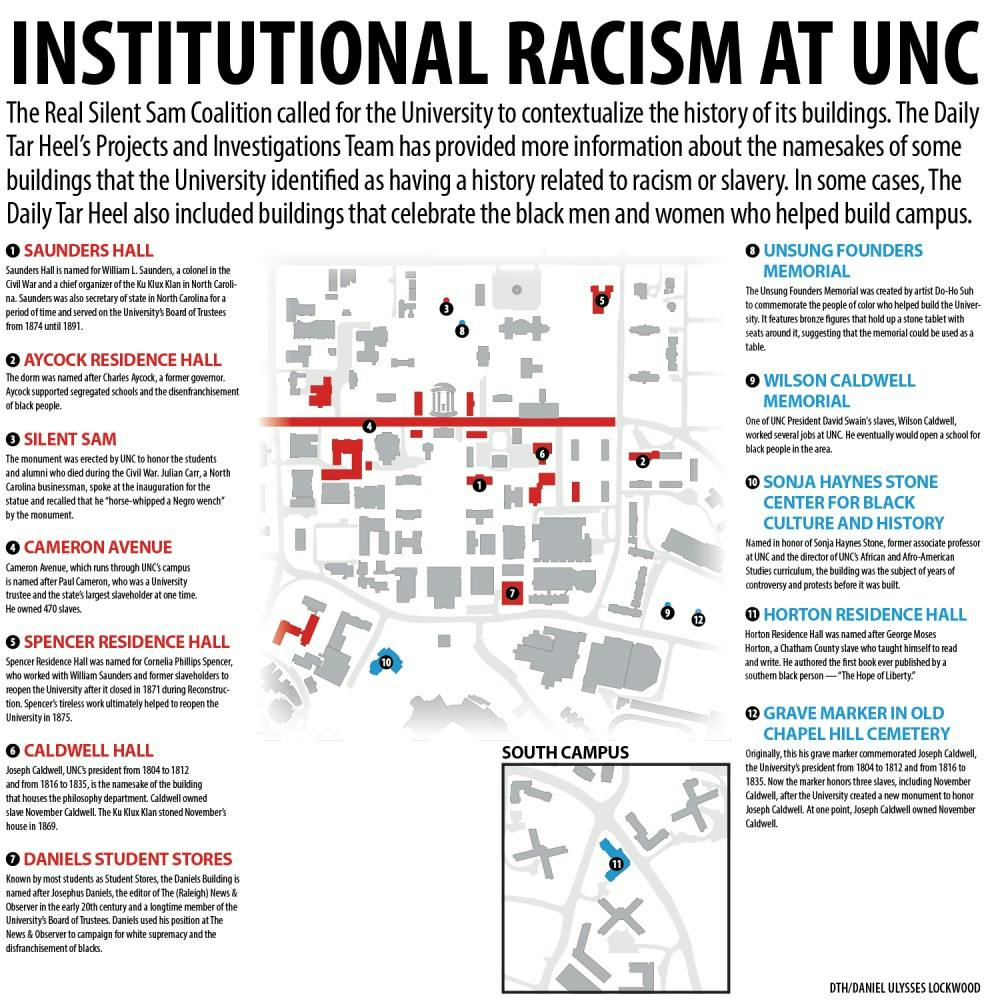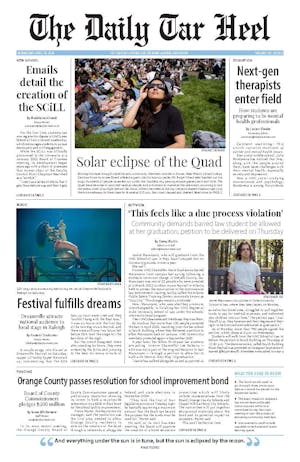Building Name: Old West
Date Constructed: 1823
Contextualized History: Old West was built by contracted slave carpenters. It is currently a dormitory on North Campus.
Building Name: Spencer Residence Hall
Date Constructed: 1924
Contextualized History: Spencer Residence Hall was named for Cornelia Phillips Spencer, who worked with William Saunders and former slaveholders to reopen the University after it closed in 1871 during Reconstruction. Spencer’s tireless work ultimately helped to reopen the University in 1875.
Building Name: Daniels Building
Date Constructed: 1968
To get the day's news and headlines in your inbox each morning, sign up for our email newsletters.
Contextualized History: Known by most students as Student Stores, the Daniels Building is named after Josephus Daniels, the editor of The (Raleigh) News & Observer in the early 20th century and a longtime member of the University’s Board of Trustees. Daniels used his position at The News & Observer to campaign for white supremacy and the disfranchisement of blacks.
Building Name: Hamilton Hall
Date Constructed: 1972
Contextualized History: Hamilton Hall was named for J.G. de Roulhac Hamilton, who taught at the University from 1906 to 1948. In 1914, Hamilton published “Reconstruction in North Carolina,” which honored the Ku Klux Klan for restoring political power to white people.
Building Name: Phillips Hall
Date Constructed: 1919
Contextualized History: Named after faculty member James Phillips, who owned slaves after moving to Chapel Hill. The building now houses the astronomy and physics departments.
Building Name: Silent Sam
Date Constructed: 1913
Contextualized History: The monument was erected by UNC to honor the students and alumni who died during the Civil War. Julian Carr, a North Carolina businessman, spoke at the inauguration for the statue and recalled that he “horse-whipped a Negro wench” by the monument.
Building Name: Sonja Haynes Center for Black Culture and History
Date Constructed: Opened 2004
Contextualized History: Named in honor of Sonja Haynes Stone, former associate professor at UNC and the director of UNC’s African and Afro-American Studies curriculum, the building was the subject of years of controversy and protests before it was built.
Building Name: Caldwell Hall
Date Constructed: 1912
Contextualized History: Joseph Caldwell, UNC’s president from 1804 to 1812 and from 1816 to 1835, is the namesake of the building that houses the philosophy department. Caldwell owned slave November Caldwell. The Ku Klux Klan stoned November’s house in 1869.
Building Name: Gerrard Hall
Date Constructed: 1837
Contextualized History: Slaves were contracted as masons, plasterers and laborers to work on Gerrard Hall.
Building Name: Ruffin Hall
Date Constructed: 1922
Contextualized History: UNC trustee Thomas Ruffin served on the N.C. Supreme Court, where he delivered a huge blow in the fight for equal rights. He banned the prosecution of masters for mistreating slaves.
Building Name: Aycock Residence Hall
Date Constructed: 1924
Contextualized History: The dorm was named after Charles Aycock, a former governor. Aycock supported segregated schools and the disenfranchisement of black people.
Building Name: Swain Hall
Date Constructed: 1914
Contextualized History: Named after University president David Swain, a slaveholder.
Building Name: Wilson Caldwell monument
Date Constructed: 1837
Contextualized History: One of UNC President David Swain's slaves, Wilson Caldwell, worked several jobs at UNC. He eventually would open a school for black people in the area.
Building Name: Mitchell Hall
Date Constructed: 1964
Contextualized History: Mitchell Hall was named for Elisha Mitchell, a professor and a prominent slaveholder who authored the pro-slavery book “The Other Leaf of the Book of Nature and the World of God.” Mitchell believed slavery was beneficial to black people because they were a “race of inferior moral and mental endowments.”
Building Name: Gen. Benjamin Smith Hall
Date Constructed: 1851
Contextualized History: Known to students as the Old Playmakers Theatre, this building was named after Benjamin Smith, a Brunswick County native who owned 221 slaves. He was appointed to be a member of the University’s Board of Trustees in 1789.
Building Name: Horton Residence Hall
Date Constructed: 2002
Contextualized History: Horton Residence Hall was named after George Moses Horton, a Chatham County slave who taught himself to read and write. He authored the first book ever published by a southern black person — “The Hope of Liberty.”
Building Name: Unsung Founders, Bond and Free Memorial
Date Constructed: 2005
Contextualized History: The Unsung Founders Memorial was created by artist Do-Ho Suh to commemorate the people of color who helped build the University. It features bronze figures that hold up a stone tablet with seats around it, suggesting that the memorial could be used as a table.
Building Name: Grave marker in Old Chapel Hill Cemetery
Date Constructed: 1904
Contextualized History: Originally, this his grave marker commemorated Joseph Caldwell, the University’s president from 1804 to 1812 and from 1816 to 1835. Now the marker honors three slaves, including November Caldwell, after the University created a new monument to honor Joseph Caldwell. At one point, Joseph Caldwell owned November Caldwell.
Building Name: Cameron Avenue
Date Constructed: 1885
Contextualized HIstory: Cameron Avenue, which runs through UNC’s campus is named after Paul Cameron, who was a University trustee and the state’s largest slaveholder at one time. He owned 470 slaves.
CORRECTION: Due to a reporting error, a previous version of this graphic and map included several fact errors. The story incorrectly identified the person after whom Murray Hall was named. The hall was named after UNC chemistry professor Royce Murray. This highlight has been removed from the map because it does not relate to UNC's racial history.
The section about the Wilson Caldwell memorial inaccurately identified the UNC president who owned Wilson Caldwell as a slave. Caldwell was owned by UNC President David Swain.
The article also incorrectly identified Sonja Haynes Stone as the first black female professor at UNC. Hortense McClinton was the first black faculty member hired by UNC. Stone was an associate professor and the director of UNC’s African and Afro-American Studies curriculum.
The section on Spencer Residence Hall failed to note that the University closed in 1871 during Reconstruction, and it was after that point that Cornelia Phillips Spencer worked to reopen the University, which it did in 1875.
The story has been updated to reflect these changes. The Daily Tar Heel apologizes for these errors.



